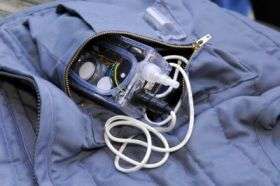Investigating causes of asthma attacks: New sensor system monitors environmental exposure

Researchers at the Georgia Tech Research Institute (GTRI) have developed a sensor system that continuously monitors the air around persons prone to asthma attacks. Worn in the pockets of a vest, the new system could help researchers understand the causes of asthma attacks.
“We are investigating whether we can go back after an asthma attack and see what was going on environmentally when the attack started,” said Charlene Bayer, a GTRI principal research scientist.
This research was supported by the U.S. Department of Housing and Urban Development and initial funding from the GTRI Independent Research and Development (IRAD) program.
Although no one fully understands why certain people get asthma, doctors know that once a person has it, his/her lungs can overreact to environmental stimuli causing chest tightness or breathlessness, known as an asthma attack.
The new sensor system measures airborne exposure to formaldehyde, carbon dioxide, ozone, nitrogen dioxide, temperature, relative humidity and total volatile organic compounds (VOCs). VOCs are emitted as gases from products such as paints, cleaning supplies, pesticide formulations, building materials and furnishings, office equipment and craft materials.
In addition to detecting the seven environmental stimuli mentioned above, a special mesh filter collects particles. A pump pulls air through the filter so that the quantity of particles can be measured at the end of the sampling period. The composition of the collected particulate can also be analyzed in the laboratory.
The battery-powered system fits into the pocket of a vest and contains commercially available sensors that were integrated into a single system by Mark Jones, chief executive officer of Keehi Technologies.
“The device weighs less than one pound including batteries and it takes a measurement of air every two minutes, stores the data in on-board memory and then sleeps to conserve battery power,” said Jones.
Bayer and GTRI Research Scientist Robert Hendry calibrated and tested the sensors in a large room-sized chamber that simulates real-world environmental conditions inside buildings. Coupled with sensitive mass spectrometers, the chamber allows the changing indoor air chemistry to be studied in detail.
The sensor system is designed to be comfortably worn in the pockets of a vest throughout the day and kept at the bedside while sleeping at night. Another vest pocket contains an electronic peak flow meter to periodically measure pulmonary function. When experiencing an asthma attack, the vest wearer notes what time it occurred and Bayer can examine the levels of the chemical compounds at that time.
Six adult volunteers have tested the vest for comfort and the effectiveness of the sensor system under actual use conditions. And that has already brought benefits for one volunteer, whose vest detected higher volatile organic exposures in his home than anywhere else. That led researchers to discover a pollutant pathway from the volunteer’s basement garage into the living areas that was allowing automobile exhaust and gasoline fumes to invade the house.
With future funding, Bayer hopes to develop a smaller and more sensitive sensor system, test the current vest in population studies of asthmatic children and develop software to process the population studies data as it is collected.
“With this system we can determine what children are exposed to at home, at school and outside where they play,” said Bayer. “Chances are there are some overreaching compounds that seem to trigger asthma attacks in more children.”
Source: Georgia Institute of Technology





















